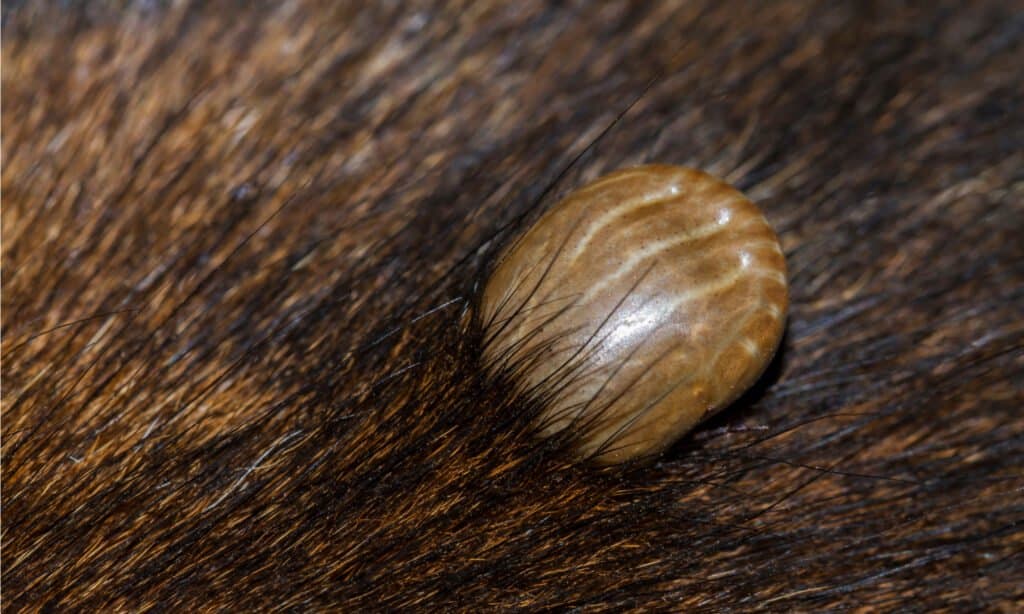Brown Dog Tick
.jumbotron {
background-image: url(“https://a-z-animals.com/media/2022/02/Brown-Dog-Tick-header-400×300.jpg”);
}
}
@media only screen and (min-width: 641px) and (max-width: 920px) {
.jumbotron {
background-image: url(“https://a-z-animals.com/media/2022/02/Brown-Dog-Tick-header-470×370.jpg”);
}
}
@media only screen and (min-width: 921px) {
.jumbotron {
background-image: url(“https://a-z-animals.com/media/2022/02/Brown-Dog-Tick-header.jpg”);
}
}
Brown Dog Tick
Rhipicephalus sanguineus
Can live its entire life indoors
Brown Dog Tick Scientific Classification
- Kingdom
- Animalia
- Phylum
- Arthropoda
- Class
- Arachnida
- Order
- Ixodida
- Family
- Ixodidae
- Genus
- Rhipicephalus
- Scientific Name
- Rhipicephalus sanguineus
Read our Complete Guide to Classification of Animals.
Brown Dog Tick Conservation Status
Brown Dog Tick Locations

Brown Dog Tick Facts
- Prey
- Blood
- Name Of Young
- Larvae
- Group Behavior
-
- Solitary
- Fun Fact
- Can live its entire life indoors
- Biggest Threat
- Ingestion by mites or nematodes
- Most Distinctive Feature
- Narrow, almost rectangular body
- Other Name(s)
- Kennel tick, dog tick
- Gestation Period
- 1-30 days
- Litter Size
- 3,000-7,000 eggs
- Diet
- Omnivore
- Type
- Arachnid
- Common Name
- Dog tick
- Number Of Species
- 1
- Location
- Everywhere humans live
- Group
- Ticks
Brown Dog Tick Physical Characteristics
- Color
-
- Brown
- Skin Type
- Exoskeleton
- Lifespan
- 3-18 months
- Length
- 2-10 mm
- Age of Sexual Maturity
- 30-600 days
This post may contain affiliate links to our partners like Chewy, Amazon, and others. Purchasing through these helps us further the A-Z Animals mission to educate about the world’s species..

Spiders that fly! Fish that walk! And 1000+ more incredible animals. Discover them all for FREE
.photo-gallery {
–margin: 0px auto 0px;
–padding: 0px 0px 0px 0px;
}
.gallery-link {
background-image: url(“https://a-z-animals.com/media/2022/02/Brown-Dog-Tick-header-1024×614.jpg”);
background-repeat: no-repeat;
background-size: cover;
background-position: center;
height: 500px;
justify-content: center;
text-align: center;
align-items: center;
display: flex;
border: 2px solid #000;
}
.gallery-link img {
height: 50%;
}
@media only screen and (max-width: 768px) {
.gallery-link {
height: 300px !important;
}
}
View all of the Brown Dog Tick images!
“Brown dog ticks are the only species of tick that infests indoor areas.”
When people think of ticks, they generally think of them as being outdoor insects. This is true, for the most part. The one exception to this outdoor lifestyle is the brown dog tick. Brown dog ticks actually spend most of their lives indoors, feeding off dogs in homes or kennels. Like all tick species, the brown tick spends its life drinking blood. And, if there are no suitable hosts to be found, it can go up to 600 days without a meal.
The brown dog tick comes from a long line of ticks stretching back to the Cretaceous era, 100 million years ago. Though we often think of them as bugs, like cockroaches or beetles, ticks are actually arachnids. They’re closely related to mites, spiders, and scorpions. Today, there are over 900 species of tick living on every single continent, even Antarctica. Out of all those species, the brown dog tick is perhaps the biggest nuisance to dog owners. Read on to learn more about the brown dog tick, and what to do if you find one on your dog.
4 Incredible Brown Dog Tick Facts!
- Brown dog ticks feed almost exclusively on dogs
- Both males and females are red-brown in color
- Females can lay up to 7,000 eggs
- Brown dog tick larvae and nymphs are often mistaken for other species
Brown Dog Tick Species, Types, and Scientific Name
The brown dog tick’s scientific name is Rhipicephalus sanguineus. Like American dog ticks, they’re commonly known as dog ticks. Ticks were first observed in North America as early as 1754; it’s possible that brown dog ticks have been biting dogs for a very long time in North America. Today, they are the only type of tick known to infest man-made structures. Unlike cockroaches, who come inside looking for garbage and leftover food to eat, brown dog ticks actually come indoors to feed on dogs.
Appearance: How to Identify Brown Dog Ticks
Brown dog ticks are members of the hard-bodied tick family, Ixodidae. In hard-bodied ticks, the mouthparts are located at the front of the abdomen. Brown dog ticks’ mouthparts are especially short and blunt compared to other species of tick, like the lone star tick. Their abdomens also look a little different than other common species of tick. Like all ticks, adults have eight segmented legs—though larval ticks start life with only six legs.
Adult brown dog ticks look so dissimilar from young brown dog ticks that they’re often mistaken for separate species by anxious dog owners. Young ticks are a pale brown color, with light-colored legs and red-brown markings on their abdomens. In contrast, adult brown dog ticks are uniformly red-brown, though, when they’re fully engorged with blood, their abdomens turn pale beige.

Worraket/Shutterstock.com
How Many Legs Do Brown Dog Ticks Have?
Brown dog ticks have eight legs divided into seven segments per leg. Each leg is tipped with a claw, much like a scorpion’s leg. They use their front pair of legs to grab onto passing canines, climbing their bodies until they find a suitable spot to attach.
Dog ticks use their mouthparts to cut a tiny hole in the skin; they actually excrete an anesthetizing liquid that numbs the injury, so victims often don’t even know they’ve been bitten. Then, using an organ called a hypostome (also located in the mouthparts) the tick anchors itself to the wound, and settles down to feed.
When not engorged with blood, the dog tick’s abdomen is narrow and rounded, like a flattened oval. After feeding, the abdomen appears incredibly distended, like a blister ready to pop. It often turns a pale, tan color, and may initially be mistaken for a wart on the dog.
Life Cycle: How to Identify Brown Dog Tick Eggs
Ticks are born in the thousands from clusters of eggs that look like piles of brown caviar. The larvae are incredibly tiny; they have only six legs, and semi-translucent abdomens. After a single feeding, usually on something small like a mouse or even a rat, the larvae fall off the host, molts, and emerge as a nymph.
Nymphs have eight legs, they can attack larger prey than can larvae. After a clutch of eggs hatches, it’s not uncommon to find many nymphs attached to a single dog. At each stage of life, the brown dog tick remains attached to its host for between 3-15 days. Molting can take up to two weeks, though every stage can be extended if suitable hosts are not available.
After molting, the nymph turns into an adult brown dog tick. Adults are the largest of all; females are capable of increasing their weight by 600 times through feeding. Males often feed for just a few hours or days before switching to a new host. In the meantime, they seek out females to procreate with. Females, on the other hand, stay attached to a single host and don’t disengage until they’re fully engorged with blood and ready to lay eggs.
The entire lifecycle can take place in as little as a few months, or take as long as 2-3 years. It all depends on the availability of food sources.
Habitat: Where to Find Brown Dog Tick
Unfortunately, brown dog ticks are found all over the world. The only things they need to survive are indoor areas, and dogs. They’re most often found in homes with dogs, kennels, or animal shelters. They tend to stay close to the ground, near baseboards, or in cracks or crevices. They’ve also been known to scale dog crates, and infest any bedding or rugs frequented by canines.
Diet: What do Brown Dog Ticks Eat?
Brown dog ticks eat one thing and one thing only: blood. In the same way that many species of cat are obligate carnivores, and need only meat to survive, ticks are obligate hematophages, and need only blood to survive. They’re one of the only species of tick to gain most of their nourishment from dogs, though they will also prey on cats, humans, or other creatures around the house.
What Eats the Brown Dog Tick?
As larvae, brown dog ticks are most often preyed on by mites and nematodes. As indoor insects, they don’t have many natural predators. Spiders, mice, and even rats will make a meal of a tick though if given the chance. Any brown dog tick that moves outdoors is vulnerable to predation by birds.
Prevention and Treatment: Brown Dog Tick Bites
If you find a brown dog tick on your dog, the first step is to remove it. Do not use your fingers—ticks can secrete harmful substances that may be absorbed into the skin. Instead, use either tweezers or tick removal tools. Firmly grasp the tick’s body near the skin, then pull with steady, slow pressure. Once the tick is fully removed, clean the area with alcohol.In order to prevent further bites, clean every area the dog frequents. Vacuum or sweep floors thoroughly, and wash all bedding. Check your dog frequently for ticks; the process of eliminating a brown dog tick infestation may take several weeks. You don’t have to worry too much about Lyme disease when it comes to brown dog tick bites; they’re more likely to spread Rocky Mountain spotted fever.
View all 192 animals that start with B
Sources
- University of Rhode Island, Available here: https://web.uri.edu/tickencounter/species/brown-dog-tick/
- University of Florida, Available here: https://entnemdept.ufl.edu/creatures/urban/medical/brown_dog_tick.htm















